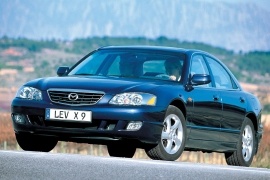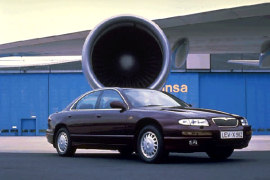MAZDA Xedos 9 Models/Series Timeline, Specifications & Photos
First production year: 1993
Engines: Gasoline
In 2001, Mazda introduced a facelifted version of its upmarket version Xedos 9, or Millenia on the U.S. market, and tried again to get more customers. But it failed.
While the competition grew stronger in the late '90s, Mazda still pushed the Millenia/Xedos 9 on various markets. It tried to achieve the same status as the Lexus or the Acura, but the customers didn't buy it. So, despite its revolutionary design and unique technical features, it failed, and the nameplate never returned to Mazda's inventory.
During the facelift, the carmaker made a new front fascia design. While its predecessor featured smaller, rounded headlights, the 2001 model was bolder, with new-edge-inspired lines for the headlamps. The grille was also slightly more angular like a wide shield pointed downwards to the bumper. Mazda placed chromed trims on wherever it could, including on the gutters and the surroundings of the window. At the back, the rounded shapes of the trunk lid and taillights were slightly adjusted to fit in the new-edge design trend. Yet, its biodesign origins couldn't be forgotten.
Inside, the carmaker tried to create a premium appearance, with a nicely curved dashboard and the audio system control panel integrated atop the center stack, very easy to reach by the driver. In the instrument cluster, Mazda placed large dials and an LCD below the speedometer. Depending on the trim level and options, the owner was either spoiled by velour upholstery or leather. At the back, there was room enough for three adult passengers.
For the technical department, the carmaker had to make some concessions in terms of power to comply with new emissions regulations.
At the beginning of the '90s, Mazda tried to launch a premium brand to compete against Infiniti, Acura, and Lexus. The first model which should enter the competition was the Xedos 9/Millenia.
Unfortunately for the Japanese brand, an economic crisis forced them to cancel the program. Still, the Millenia/Xedos 9 was built and remained an example of what they could do if the recession wouldn't strike them.
Sleek and streamlined, the Xedos 9 featured a slim front fascia with narrow headlights and a grille that didn't resemble any other Mazda on the market. The curved surfaces and flowing lines went into an ascending trend toward the rear. The raked A-pillars and sloped rear windscreen improved the aerodynamic coefficient.
The interior was roomy for five adult passengers. The manufacturer installed steering-wheel buttons and a complete instrument panel that offered enough information about the driver's car and speed. On the sides of the instrument cluster, the carmaker installed warning lights for various functions. Under the door-mounted armrests, there were covered compartments.
The magic came in the technical department. The Xedos 9 was available with an all-wheel-steering system and traction control. There was a choice of three V6 engines under the hood, and the most interesting was the 2.3-liter unit. It was a Miller cycle type, which allowed the car to offer excellent fuel-efficiency for its times, even if it was mated to a 4-speed automatic gearbox. The other two were paired with a 5-speed manual. One particular advantage of the car was the fully independent suspension and the low center of gravity that helped it achieve the same speed on the elk-avoiding test as the Nissan 300 ZX or the BMW 850i.

